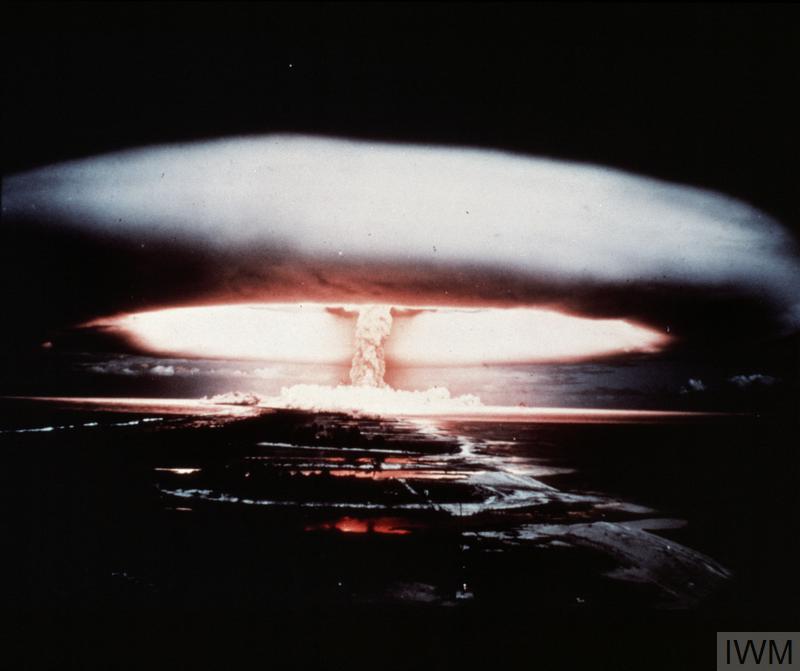British Nuclear Weapons: Part 1 Development
 |
| British Nuclear Tests in 1950s © IWM (TR 65682B) |
The Early Days
Britain was one of the first countries to look into the developments of atomic energy. In 1917, British physicist, Ernest Rutherford was the first person to split the atom which ignited curiosity of what this could lead to.
By 1939, the discovery of nuclear fission introduced the concept of nuclear energy and also nuclear weapons.
 |
| Photograph of Churchill, Truman and Stalin at the Yalta Conference, 1945. (The National Archives Catalogue ref: CO 1069/892) |
Second World War
The Frisch-Peierls Memorandum outlined that a nuclear bomb could indeed be made and it also outline the catastrophic impact that would take place if ever used. This sparked concern amongst the British and American governments who believed that Hitler might be working on a 'secret weapon' of his own. The memorandum stated:
"If one works on the assumption that Germany is, or will be, in the possession of this weapon, it must be realized that no shelters are available that would be effective and could be used on a large scale. The most effective reply would be a counter-threat with a similar bomb." - Frisch-Peierls Memorandum via Atomic Heritage Foundation
"If one works on the assumption that Germany is, or will be, in the possession of this weapon, it must be realized that no shelters are available that would be effective and could be used on a large scale. The most effective reply would be a counter-threat with a similar bomb." - Frisch-Peierls Memorandum via Atomic Heritage Foundation
The British government stepped up its efforts to create their own atomic bomb. When Winston Churchill became Prime Minister of Great Britain, he created the MAUD Committee to advise the government on the development of their own nuclear programme. Their 1941 report concluded that a bomb should be built in collaboration with the United States. Later that year President Roosevelt sought collaboration with Britain but Churchill wanted to maintain independence as the British nuclear programmed was much more advanced.
By 1942, the tables had turned as the US had made significant advancements. As a result Churchill agreed to merge projects. This was confirmed by the 1943 Quebec Agreement. Many British scientists relocated to America to work on the Manhattan Project.
In 1944, Churchill gave Roosevelt his support at the idea of using nuclear weapons against Japan. Formal consent was then given to the US on 4 July 1945 and Churchill personally reiterated this to the new president, Truman, later that month at the Potsdam Conference. According to historian Jacques Hymans, British consent in the Hiroshima and Nagasaki bombings is severely overlooked by many other historians.
 |
| © IWM (GOV 9111) |
Post-War
In 1946, Truman closed off collaboration with Britain. A year later, the new British Prime Minister, Clement Atlee, authorised British scientists to develop a British bomb. The project utilised the British scientists who had worked on the Manhattan Project to do so.
The successful testing of a Soviet Atomic Bomb in 1949 sparked fear and the US began to reconsider collaboration. During the early 1950s it became apparent that the British nuclear project has been infiltrated by Soviet spies. As a result of adamant American anti-Soviet beliefs, any hope of co-operation was destroyed and Britain was prohibited from testing its bombs in Nevada.
Despite this, the first British Atomic Bomb was tested in Australia on 3 October 1952 during Operation Hurricane. It was then deployed for military operational use in 1953. Four years later, Britain's hydrogen bomb was tested.
It became increasingly obvious that if nuclear weapons were used it was create mutually assured destruction due to their detrimental effects. In 1957, Britain officially stated that nuclear strategy would be based on deterrence.
 |
| BAE Systems: Vickers Valiant BK1 RAF (WZ376) refuelling Vulcan B1 RAF (XH478) |
V-Bombers
V-Bombers is the name given to the bomber planes that would be used to deliver British nuclear weapons if they were ever to be used. This comprised of Vickers Valiant, Victor and Vulcan bomber planes.
The Vickers Valiant entered service in 1955, performed the first hydrogen bomb tests in 1957 and 1958. This led to the introduction of the Yellow Sun, Britain's first operational nukes. Throughout the 1960s, all RAF bases had at least two V-Bombers loaded with nuclear weapons on standby. However, due to the improvement of the improvement of Soviet interceptors, V-Bombers soon became outdated and were replaced by the Polaris system, which is what we will look at in Part 2 of British Nuclear Weapons.
Share your facts about British nuclear weapons in the comments below!
Further Reading:
The British Nuclear Programme https://www.atomicheritage.org/history/british-nuclear-program
Meet Britain's Very Own B-52: The V-Bombers https://nationalinterest.org/blog/buzz/meet-britains-very-own-b-52-v-bombers-38197
How Did Britain Get Involved in the Nuclear Arms Race? https://www.bbc.com/timelines/z33fycw
British Policy on USSR 1947, The National Archives, Ref: CAB 21/1800 http://www.nationalarchives.gov.uk/education/resources/cold-war-on-file/british-policy-on-ussr-1947/
Richard Moore, Where Her Majesty's Weapons Were, Bulletin of the Atomic Scientists 2001, https://journals.sagepub.com/doi/full/10.2968/057001019
Britain and Hiroshima, Jacques E.C. Hymans, Journal of Strategic Studies 2009, file:///C:/Users/amii-/Downloads/BritainandHiroshimaJSSfinal.pdf
Vickers Valiant https://www.baesystems.com/en/heritage/vickers-valiant



